I was advised to “put the map away and let the garden guide you through the space” even before entering Hidcote Manor Garden, one of the most influential gardens in England. Given the scale of the garden, this was not an insignificant suggestion, and it made the experience truly eye opening. A great garden, as Hidcote is, has a sense of flow, pulling you through the space as though the designer is giving you a tour without even being there.
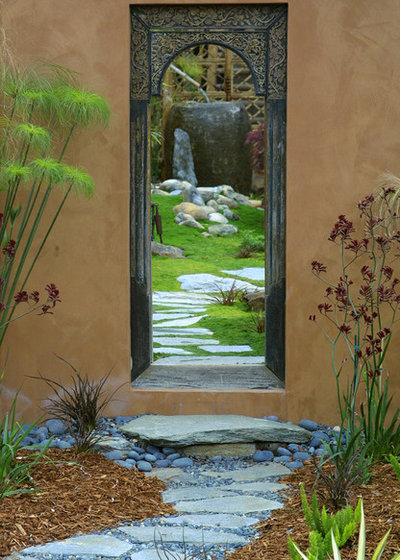
Margie Grace - Grace Design Associates
This doesn’t just happen by coincidence; the most effective garden designs all employ methods to keep a visitor engaged with the landscape. They play off the senses and create a sense of mystery and intrigue. Iconic gardens offer lessons for creating truly compelling gardens of our own, regardless of how much room we have.
Here are some of the features I have come across that make for an unforgettable garden experience.
1. A defined entry. The entrance to a garden is an important feature that should be considered. It is a great opportunity to create a dramatic effect that sets the tone for the rest of the garden experience.
Think contrast with your garden entrance, the more the better. The entrance doesn’t need to be grand; a simple transition between a shaded environment and a well-lit, open space is enough to signal to visitors that they have entered into the garden.
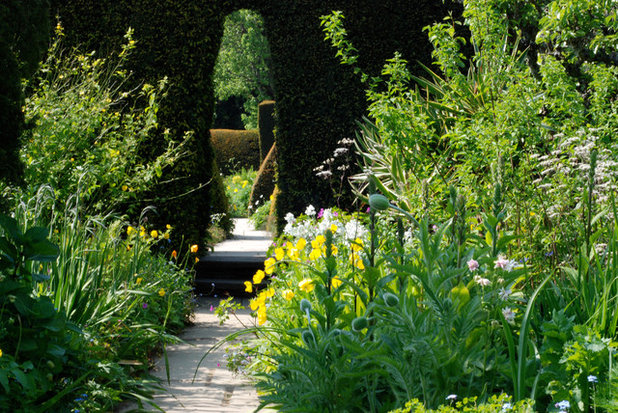
Matt Kilburn
2. Cutout windows in hedging and walls. In the same way that an entrance focuses the view to a single vignette, cutouts in hedging and walls are an effective way to frame features and create interest in your garden. Whether it’s a peek through to another area of your garden or a “borrowed” view of a landscape element beyond the boundary of your site, windows cut into hedging and walls are a great way to engage the garden visitor.
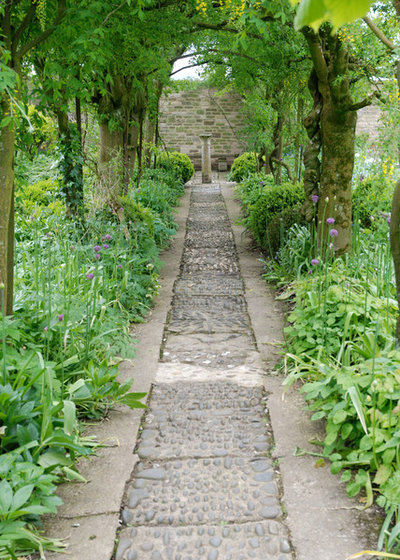
Matt Kilburn
3. Paths that hint at a destination. A garden path should always lead somewhere; this is seemingly obvious but sometimes overlooked.
Whether it is another area of the garden or a landscape feature tucked into the framework of the space, a destination at the end of a path is crucial. Hinting at an area of interest at the end of a path is a great way to get garden visitors to explore the far reaches of your garden, and it’s a perfect opportunity to showcase garden art or a favorite piece of garden furniture.
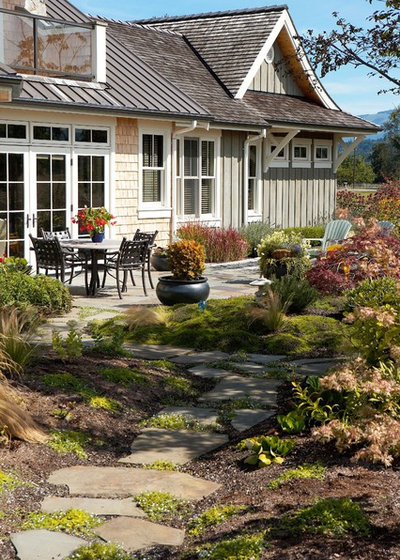
Lankford Associates Landscape Architects
4. Changes in path materials. Consideration should be given to the size and materials of garden paths, as this can greatly enhance the experience in your garden. Larger, more defined paths allow for quicker movement and provide the opportunity to look up from the path to the surrounding environment. This works well to direct focus to features in the distance.
Smaller, more irregular paths (such as those made of flagstone or uneven brickwork) require visitors to slow their pace and direct their eyes downward. This is a great way to draw attention to the small details in the immediate surrounding area. Changing the material and/or scale of a path is also an effective way to signal the transition into a new garden room.
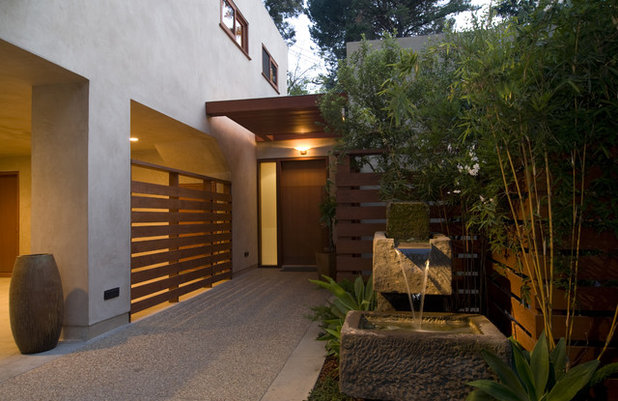
Studio William Hefner
5. Hidden water features. The sound of water is always a welcome addition to the garden. It has the ability to cover unwanted background noise and impart a sense of calm, regardless of whether it is a rushing stream or a gurgling, overflowing pot. What makes a water feature even more intriguing is when it is heard before it is seen. The sound of water acts like a beacon, compelling the garden visitor to find the source. Water features should be in a location where they can be heard in both the front and back garden, as the sound will help connect the two areas.
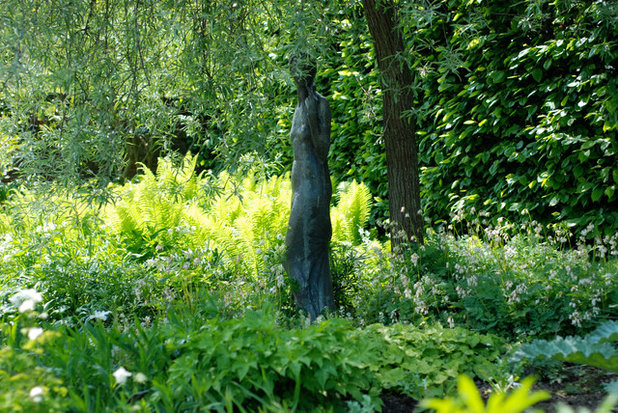
Matt Kilburn
6. Foliage color that draws attention. Color is one of the most powerful tools at your disposal when you’re designing your garden. Choosing plants with foliage that contrasts the surrounding plantings is a surefire way to draw the eye to a desired area. Situating garden art in a sea of color (like this statue positioned in front of a mass of bright chartreuse ferns) makes it come alive, and different effects can be accomplished as the seasons shift and the foliage changes color.
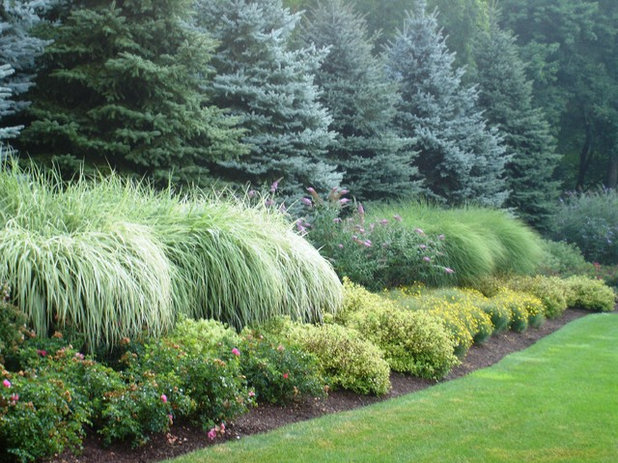
Landscape Design Associates of Westchester, Inc.
7. Green boundaries. A successful garden fits seamlessly into the landscape, an effect often aided by softening the boundaries to draw the eye back into the space. A great way to do this is to screen the hard edges of fencing and walls with masses of green foliage. Berming soil near the property boundary (as shown here) allows for perennials and trees to rise above the main grade of the garden and obscure the view of any fencing. In smaller spaces green boundaries can be obtained with vines and green walls; they create the same effect in a smaller footprint.
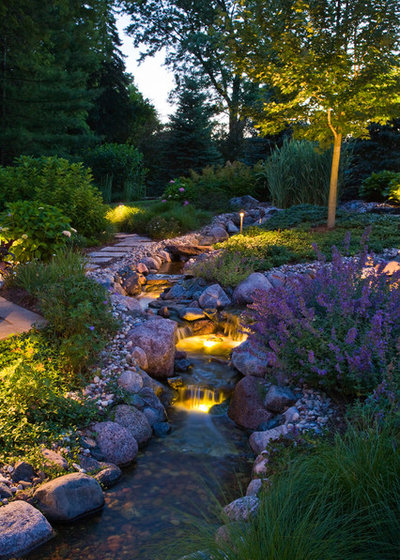
Grant and Power Landscaping
8. Alluring landscape lighting. An amazing shift happens in the garden when the sun sets. The landscape features that stood center stage during the day recede into darkness, and a whole new atmosphere can be created with creative placement of landscape lighting. Trees can be uplit, and paths can be defined by lights, leading garden visitors through the space and providing interest that can be enjoyed both outdoors and from indoors. Lighting can also be effectively incorporated into water features to add movement (and to keep people from stepping into the pond!).





